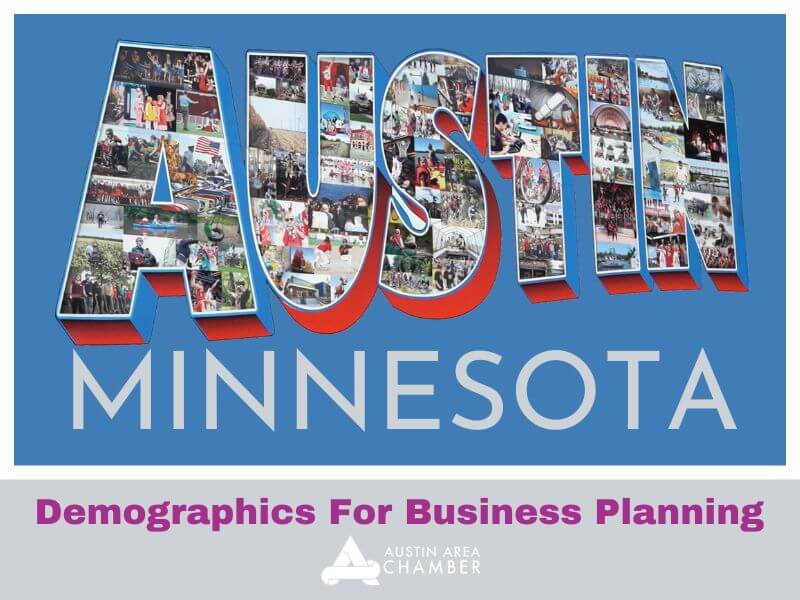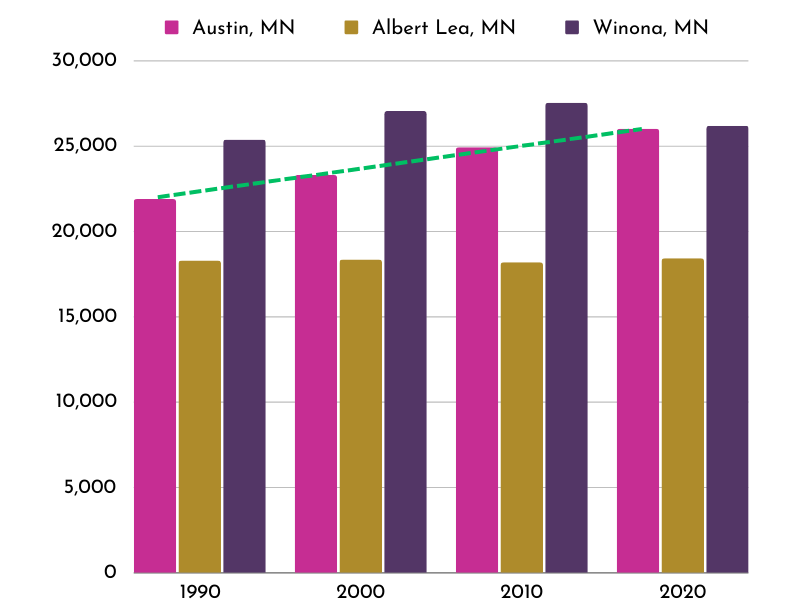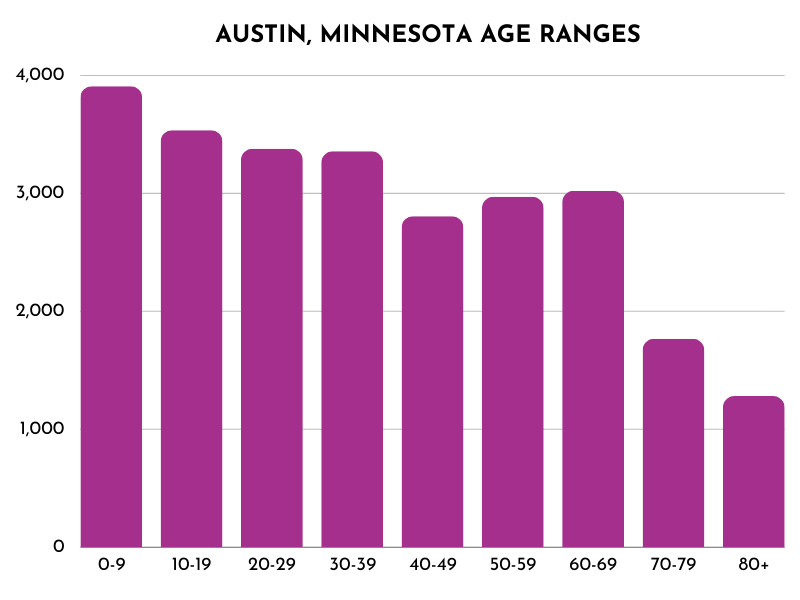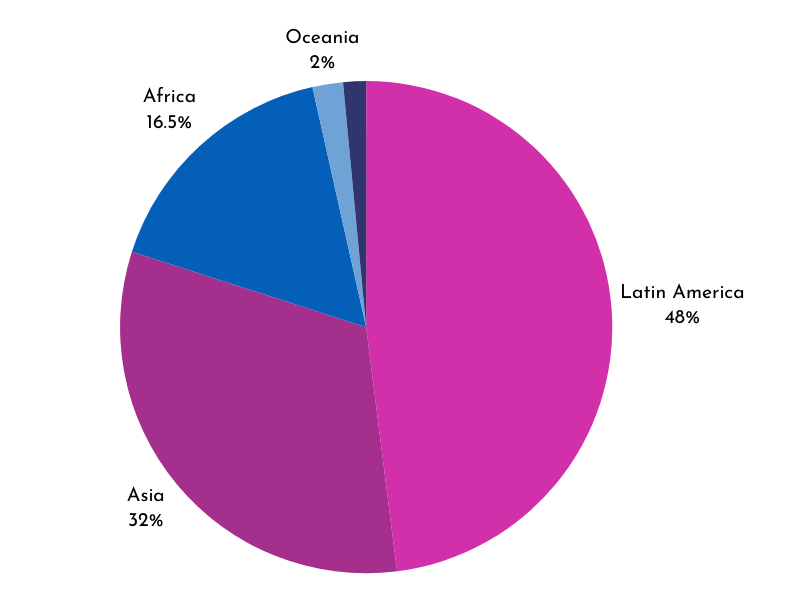Austin Business Planning: Demographics and Trends

If you’re considering starting a business in Austin, Minnesota, having a deep understanding of the local market will help you get off on the right foot. By delving into the demographics and trends shaping Austin, you can make informed decisions, like assessing your “target market” (in other words, your potential customers).
Is your potential market large enough (and willing to spend enough) to cover your costs and eventually push you into the profit zone?
This is where demographics come in – especially if your business will rely on sales from the local area.
Demographic Snapshot of Austin
At the Austin Area Chamber of Commerce, we hear it all the time: a lot has changed in Austin, Minnesota, but a lot has stayed the same. Austin is a fascinating blend of long-time residents and a culturally diverse young population: in fact, Austin is one of the most diverse small cities in Minnesota.
Let’s explore the key factors that define Austin and its potential impact on your business. Understanding the size, composition, and growth rate of the population is the first step in tailoring your products or services to meet the needs of Austin area residents.
Population
According to the U.S. Census Bureau, Austin has a population of 26,200 as of 2022, but as the county seat for Mower County, the city of Austin sits in a total county population of 40,100.
Growth Rate
 Unlike nearby Albert Lea, whose population growth has remained flat since 1990, Austin has experienced a 17% increase in residents since 1990. This growth has been “slow and steady” and could continue through new home construction and multi-unit rental properties.
Unlike nearby Albert Lea, whose population growth has remained flat since 1990, Austin has experienced a 17% increase in residents since 1990. This growth has been “slow and steady” and could continue through new home construction and multi-unit rental properties.
Economics
Residents. Although large employers like the Mayo Clinic Health System, Hormel Foods, and the Hormel Institute, among others, offer employees high-paying, high-skilled jobs, most of Austin’s residents retain blue collar jobs or on fixed incomes as retirees. The median individual income (2017-2021) for Austin is only $28,284. While that number has increased steadily from 2011, it has not kept pace with the rate of inflation. That means that more of Austin resident’s income is being consumed by rent/mortgages, food, utilities, and other necessary expenses.
TAKE AWAY: Residents' disposable income is limited; goods and services deemed essential may fare better than items perceived as luxury items.
Visitors. A bright spot that buffers the challenging data about residents’ income levels is our booming visitor population. Thanks to Austin’s proximity to Interstate 90 and the unique attraction that is the SPAM Museum, Austin sees between 80,000 and 100,000 visitors to the downtown commercial district. These visitors often exhibit a different mindset: they are on a fun adventure, they are exploring, they are on vacation.
We’ve heard it said that “vacation money is not real money.” In this more relaxed mindset, visitors may be more willing to part with money for experiences and entertainment. Here’s the challenge: many of these visitors are making a “pit stop” on road trips, and they come to downtown Austin to visit the Museum, have lunch, and hit the road again. The Austin Area Chamber of Commerce is actively working to create a vision for downtown Austin that prolongs their stay by increasing the number of businesses that offer visitors more experiences in immediate proximity of the SPAM Museum. This will include infilling downtown with more restaurants, retail, and cultural activities to encourage visitors to prolong their visits and spend more of their dollars in Austin.
TAKE AWAY: Offering goods and services that appeal to visitors may allow flexibility on price points.
The downtown commercial district isn’t the only area where visitors linger, however. The 18th Avenue NW corridor, which runs parallel to Interstate 90, is the primary location for hotels. Numerous retail, restaurant, and grocery options also line 18th Avenue, making it a popular choice for locals and visitors alike. This is not a full discussion of choosing a business location. That topic will be addressed more fully in a separate post.
Age Distribution

Although the city has a spectrum in terms of age distribution, Austin is trending younger.
Children and youth (ages 0 to 19) represent nearly 30 percent of the Austin population. The 20-39 age range represents another 30 percent. The “Middle Agers” (ages 40 to 59) represent only 22 percent, and senior citizens (60+) represent only 24 percent.
To state it clearly: 60 percent of Austin’s population are under 40. This understanding may affect many important parts of your business, from the products and services you offer, the platforms and style you choose for marketing, how you will deliver goods and services, and even your business name.
Languages Spoken
English remains the dominant language in Austin; however, the Austin Public Schools reported serving students who speak more than 45 different home languages. In fact, 16 percent of the Austin population was born outside of the United State, which is a rate that is nearly double for the rest of Minnesota. Combining that information with the age demographics discussed above, not only is Austin trending younger, but its younger population is more likely to be bilingual or multilingual than the older generations.
Of the total foreign-born population, 48 percent were born in Latin America, where Spanish is the primary language spoken. An additional 32 percent of foreign-born residents emigrated from Asia and 16 percent from Africa, both large continents comprised of very diverse ethnic and language groups.
 What does this mean for your business? It means you can’t assume that Austin is a homogenous community of white, American-born, English-speaking people. Your potential customers and employees will reflect Austin’s growing diverse population, and, as such, may not have English as their first language. This might affect how you market within specific demographic segments with tailored messaging, perhaps in multiple languages and styles. It also may require unique approaches to employee training to make sure: 1). Your staff is prepared to serve a diverse community; 2). As an employer, you’re ready to support the needs of a diverse workforce.
What does this mean for your business? It means you can’t assume that Austin is a homogenous community of white, American-born, English-speaking people. Your potential customers and employees will reflect Austin’s growing diverse population, and, as such, may not have English as their first language. This might affect how you market within specific demographic segments with tailored messaging, perhaps in multiple languages and styles. It also may require unique approaches to employee training to make sure: 1). Your staff is prepared to serve a diverse community; 2). As an employer, you’re ready to support the needs of a diverse workforce.
Educational Levels
Of the Austin residents who are age 25 years or older, 86 percent have graduated high school, and 24% have attained a bachelor’s degree or higher, which is lower than Minnesota’s overall bachelor’s rate of 38%. This lower rate is due, in part, to Austin’s legacy of blue collar jobs for which manual and skilled laborers aren’t required to have four-year college degrees. Other factors affecting high school graduation rates include an influx of foreign-born workers of varying educational backgrounds, and the fact that local high school graduates interested in four-year degrees (outside of elementary education, social work, nursing programs offered at Riverland Community College) must complete their college education outside of Austin.
Income Levels
The median household income in Austin, Minnesota is $54,000, with nearly half of households making less than $50,000. In fact, 80 percent of Austin households make less than $100,000. This reinforces the idea stated above that residents have limited disposable income, favoring goods and services deemed essential. There is, however, some play in what a customer might deem as essential. For example, ask many women in Austin about their hair and aesthetic providers, and you will hear just how essential they deem those appointments. Non-negotiable!
Utilizing Data for Business Success
Armed with these insights into Austin’s demographics and trends, you can now tailor your business strategies to align with the needs and preferences of the local community. Whether you are launching a new business or aiming for growth, the key is to stay connected with the heartbeat of Austin.
In future posts, we will delve deeper into specific aspects of Austin’s market, providing actionable tips to help your business thrive in our unique community. Stay tuned for more insights and guidance on navigating the local landscape!
Have questions? Give us a call at (507) 437-4561 or email us at info@austincoc.com.

by Chaunce Stanton
Director of Marketing & Communications
Austin Area Chamber of Commerce

